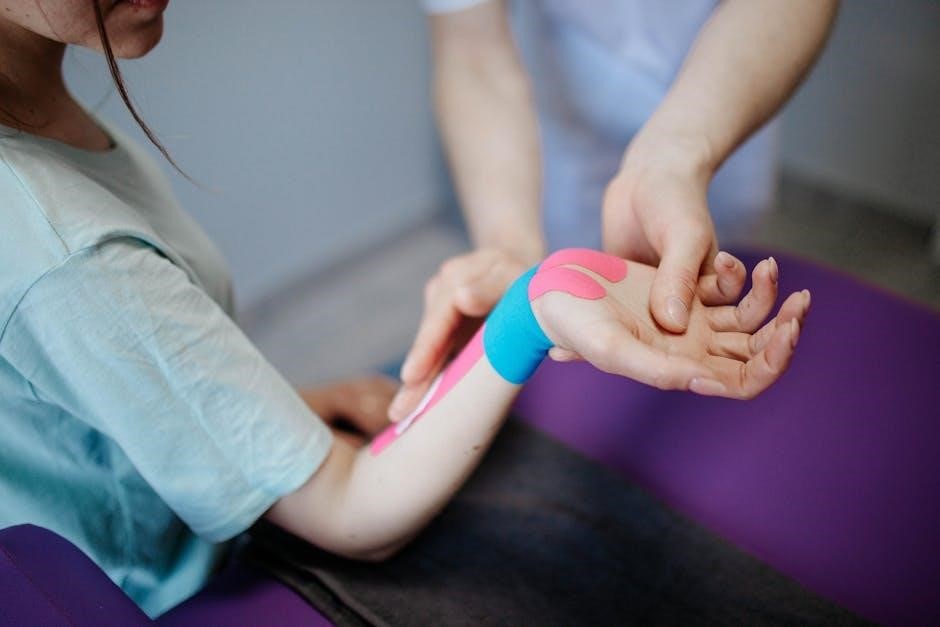Tongue exercises are essential for improving speech clarity, strengthening oral muscles, and enhancing swallowing abilities. They target muscle coordination, flexibility, and strength, guided by speech therapists to ensure effectiveness and safety.
1.1 Importance of Tongue Exercises in Speech Improvement
Tongue exercises play a vital role in improving speech by strengthening oral muscles, enhancing coordination, and boosting articulation skills. They are particularly beneficial for addressing speech disorders, such as articulation difficulties or swallowing challenges. By improving tongue strength, flexibility, and range of motion, these exercises help individuals produce clearer sounds and achieve better speech clarity. Speech therapists often recommend them as part of personalized treatment plans, tailoring exercises to meet specific needs. Regular practice can lead to significant improvements in communication abilities, making tongue exercises an essential component of speech therapy for both children and adults. Consistency and proper guidance are key to maximizing their benefits.
1.2 Overview of Speech Therapy and Its Goals
Speech therapy is a specialized approach aimed at improving communication and swallowing abilities in individuals with speech or language disorders. It focuses on addressing challenges such as articulation, fluency, voice disorders, and comprehension. Speech therapists work with clients to enhance their ability to produce clear and accurate speech sounds, understand language, and communicate effectively. The primary goals of speech therapy include improving overall communication skills, increasing confidence in speaking, and addressing underlying issues like tongue weakness or swallowing difficulties. Treatment plans are tailored to individual needs, incorporating exercises, drills, and strategies to achieve measurable progress. Regular practice and professional guidance are essential for successful outcomes.

Benefits of Tongue Exercises
Tongue exercises enhance speech clarity, strengthen muscles, and improve swallowing. They boost articulation, flexibility, and coordination, leading to better communication and reduced speech-related challenges effectively.
2.1 Strengthening Tongue Muscles for Better Speech Clarity
Strengthening tongue muscles is crucial for improving speech clarity. Exercises like tongue push-ups and resistance tasks target the tongue’s intrinsic and extrinsic muscles, enhancing coordination and endurance. By building muscle strength, individuals can achieve better articulation and precision in forming sounds. Regular practice of these exercises helps reduce speech difficulties, such as slurring or mumbling. Using tools like mirrors provides visual feedback, ensuring proper technique and maximizing results. Stronger tongue muscles also improve overall oral motor control, making speech production more efficient and clear. Consistent practice is key to achieving lasting improvements in speech quality.
Improving tongue range of motion and flexibility is vital for clear and precise speech. Exercises such as side-to-side movements and stretching the tongue outward enhance its ability to move freely. These movements help in achieving proper articulation of sounds. Regular practice increases the tongue’s flexibility, allowing it to reach various positions needed for speech. Techniques like touching the nose or chin with the tongue tip also improve coordination. Better range of motion reduces speech difficulties and enhances overall communication skills. Consistent practice ensures lasting improvements in tongue mobility and speech clarity. Mirrors can be used to monitor progress and maintain proper form during exercises. Tongue exercises play a crucial role in improving swallowing and articulation skills by strengthening the muscles involved in these processes. Techniques like tongue protrusion, lateralization, and retraction help enhance coordination and control. These exercises improve the ability to move food during swallowing and form precise sounds for clear speech; Regular practice of tongue stretches and resistance exercises can also reduce difficulties in articulating certain words. Additionally, activities such as blowing bubbles or using resistance tools can strengthen the muscles used in swallowing. Consistent practice of these exercises leads to better coordination between the tongue and other oral structures, resulting in improved swallowing efficiency and clearer articulation of speech sounds. Tongue exercises include protrusion, lateralization, retraction, stretching, and push-ups. Each targets specific muscles, improving strength, flexibility, and coordination for clearer speech and swallowing. Tongue protrusion exercises involve sticking the tongue out as far as possible and holding it for several seconds. This exercise strengthens the extrinsic tongue muscles, improving speech clarity and swallowing. To perform: Tongue lateralization exercises focus on moving the tongue from side to side, enhancing flexibility and coordination. This exercise is crucial for improving articulation, especially for sounds requiring precise tongue placement. To perform: Tongue retraction exercises involve pulling the tongue back toward the throat, strengthening the posterior muscles. This improves speech clarity and swallowing efficiency. To perform: Sit or stand upright, looking straight ahead. Tongue stretching exercises aim to improve flexibility and range of motion, crucial for clear speech and effective swallowing. To perform: Tongue push-ups and resistance exercises are designed to strengthen the tongue muscles, improving speech clarity and swallowing efficiency. To perform tongue push-ups: For resistance exercises: These exercises enhance muscle strength and endurance, addressing tongue weakness and improving articulation. Regular practice, guided by a speech therapist, ensures proper technique and maximizes benefits for speech and swallowing. Aim to perform 5-10 tongue exercises, 3 times daily. Use a mirror for accurate movements and track progress to ensure consistency and improvement in speech clarity.
For optimal results, perform tongue exercises 3 times daily, with each session lasting 5-10 minutes. Start with 5 repetitions of each exercise and gradually increase to 10 as strength improves. Consistency is key to enhancing speech clarity and muscle coordination. Avoid overexertion by resting between sets and stopping if pain occurs. Use a mirror to monitor technique and ensure movements are precise. Tracking progress daily helps maintain motivation and adherence to the routine. Adjustments can be made based on individual progress and therapist recommendations. Regular practice fosters noticeable improvements in articulation and swallowing abilities over time. Incorporating tongue exercises into your daily routine can be simple and effective. Start by setting reminders or pairing exercises with daily activities like brushing your teeth or waiting in traffic. Use a mirror to ensure proper form and technique. For example, perform tongue protrusions while brushing your teeth or practice lateral movements during commercials while watching TV. Mobile apps can also help track progress and send reminders. Consistency is key, so integrate exercises into moments that feel natural to your schedule. This approach makes it easier to maintain a regular routine without feeling overwhelmed. Over time, these small efforts contribute significantly to improved speech and muscle control. Consistency is crucial for effective tongue exercises. Start with manageable goals, like performing exercises during morning and evening routines. Track progress using a journal or mobile app to stay motivated. Celebrate small achievements, such as mastering a new exercise, to maintain engagement. Incorporate variety by rotating exercises daily to prevent boredom. Consider enlisting a partner or joining an online community for support. Reward systems, like treating yourself after reaching milestones, can also boost motivation. Most importantly, remember that consistent practice, even for a few minutes each day, leads to significant improvements in speech and oral function over time. Stay committed and patient with your progress. Advanced exercises include tongue circles, figure-eight movements, blade resistance, and combined jaw-tongue coordination. These enhance strength, coordination, and precision for improved speech and swallowing abilities effectively. Tongue circles and figure-eight movements are advanced exercises that enhance coordination and precision. To perform tongue circles, move your tongue in large circular motions, first clockwise and then counterclockwise, stretching as far as possible. Figure-eight movements involve tracing the number “8” with your tongue, alternating directions. These exercises improve tongue flexibility, strength, and control, which are crucial for clear articulation and effective swallowing. They also help in refining speech patterns by increasing muscle coordination. Speech therapists often recommend these exercises for individuals with advanced oral motor challenges. Consistency is key, and using a mirror can provide visual feedback to ensure proper form. Performing 5-10 repetitions daily can lead to significant improvements in speech clarity and overall oral function. Tongue blade resistance exercises are designed to strengthen the tongue muscles using external resistance. Place a tongue blade or a flat tool like a spoon behind your teeth. Press your tongue against the blade, applying gentle to moderate resistance. Move your tongue side-to-side and up-and-down while maintaining pressure. This exercise enhances tongue strength, endurance, and coordination, which are critical for improving speech clarity and swallowing efficiency. Start with light resistance and gradually increase as your muscles strengthen. Perform 5-10 repetitions in each direction, 2-3 times daily. These exercises are particularly effective for addressing tongue weakness and improving articulation. A speech therapist can tailor the resistance level to suit individual needs, ensuring safe and effective progression. Combined jaw and tongue movements are advanced exercises that enhance coordination between the jaw, tongue, and surrounding muscles. These exercises improve speech clarity, swallowing efficiency, and overall oral motor function. One common exercise involves moving the jaw from side to side while sticking the tongue out and holding it still. Another involves opening the mouth wide and moving the tongue in a circular motion while the jaw follows. These exercises strengthen the synergy between the jaw and tongue, reducing effort during speech and swallowing. Start with slow, controlled movements and gradually increase speed. A speech therapist can tailor these exercises to address specific challenges, ensuring they are performed safely and effectively to achieve desired outcomes. Common challenges include tongue weakness, discomfort, and difficulty modifying exercises for different age groups. Solutions involve adjusting exercises, using mirrors for feedback, and seeking professional guidance from therapists. Tongue weakness and fatigue are common challenges that can hinder progress in speech therapy. To address these issues, it is essential to start with gentle exercises that gradually build strength and endurance. Begin with simple tongue protrusion and lateralization movements, holding each position for a few seconds before relaxing. Consistency is key; perform these exercises in short, frequent sessions throughout the day to avoid overexertion. Using a mirror can help ensure proper form and provide visual feedback. Avoid any exercises that cause pain or discomfort, as this may indicate overexertion. Incorporate activities that promote relaxation, such as deep breathing, to reduce fatigue. Additionally, consider incorporating fun and engaging exercises, like tongue twisters, to make the process more enjoyable and increase adherence to the routine. Remember, progress may be slow, but consistent effort will lead to noticeable improvement over time. If pain or discomfort arises during tongue exercises, it is crucial to address these sensations promptly to prevent injury or discouragement. First, stop the exercise immediately and rest the tongue. Consult with a speech therapist to modify the exercise or adjust the intensity. Gentle stretching and relaxation techniques can help alleviate discomfort. Ensure proper posture and breathing during exercises to reduce strain. Using a mirror to monitor movements can help maintain correct form and avoid overexertion. Incorporate activities that promote relaxation, such as deep breathing or tongue twisters, to make the process more enjoyable. Always prioritize comfort and safety to foster a positive and effective practice routine. Tongue exercises can be adapted to suit individuals of various ages, ensuring effectiveness and engagement. For children, exercises should be playful, incorporating games and visual aids to maintain interest. Adults may benefit from more structured and intense routines, focusing on specific speech or swallowing goals. Seniors or those with limited mobility can perform slower, gentle movements with regular breaks to avoid fatigue. Mirrors can be used across all ages to provide visual feedback and ensure proper form. Personalized plans, created in collaboration with a speech therapist, help address unique needs and abilities, making the exercises both enjoyable and beneficial for diverse age groups. Regular adjustments ensure continued progress and motivation. A speech therapist provides guidance, supervision, and customization of tongue exercises to meet individual needs. They monitor progress, adjust plans, and ensure exercises are performed safely and effectively. A speech therapist plays a crucial role in guiding and supervising tongue exercises, ensuring they are performed correctly and safely. They assess individual needs, demonstrate techniques, and provide feedback to improve speech and swallowing. By monitoring progress, therapists can adjust exercises to address specific challenges, such as tongue weakness or limited range of motion. Their expertise helps prevent injuries and maximizes the effectiveness of the exercises. Regular supervision ensures consistency and motivates patients to stay committed to their therapy plan. This professional oversight is essential for achieving measurable improvements in speech clarity and overall oral motor function. Speech therapists tailor tongue exercises to meet the unique requirements of each patient, ensuring optimal progress. They consider factors like age, diagnosis, and specific speech or swallowing challenges. For children, exercises might include fun activities like tongue twisters or oral motor games to engage them. Adults with conditions like dysarthria may focus on strength and coordination. Therapists adjust the difficulty, frequency, and duration of exercises based on individual responses, ensuring a personalized approach. This customization maximizes the effectiveness of therapy and helps patients achieve their goals more efficiently. Regular assessments allow for ongoing adjustments, keeping the treatment plan aligned with the patient’s evolving needs. Regular monitoring of progress is crucial in speech therapy to ensure exercises are effective and goals are met. Speech therapists use tools like mirrors and patient feedback to track improvements in tongue strength, range of motion, and articulation. They assess how well the patient can perform exercises and adapt the plan as needed. If progress stalls, therapists may introduce new challenges or modify existing ones to better suit the patient’s needs. Feedback from the patient is also vital, helping therapists understand any challenges or discomfort. This collaborative approach ensures the therapy remains tailored and effective, with adjustments made to keep the patient on track toward their speech and swallowing goals. Printable PDF guides offer structured tongue exercises, while mobile apps provide tracking features. Online communities and forums supply additional support and resources for speech therapy. Printable PDF guides and worksheets are excellent tools for organizing tongue exercises. They often include step-by-step instructions, visuals, and progress tracking sheets. These resources are ideal for both home practice and clinical settings, offering a structured approach to improving speech and swallowing abilities. Many PDF guides are tailored for specific needs, such as strengthening tongue muscles or enhancing articulation. They can be easily downloaded and shared with patients or clients, ensuring consistent practice. Speech therapists frequently recommend these materials as they provide clear, actionable exercises that can be customized to individual goals. Using mirror feedback alongside these guides helps users perform exercises correctly and track improvements effectively. Mobile apps are valuable tools for maintaining consistency in tongue exercises. They provide reminders to ensure daily practice and track progress over time. Many apps offer customizable exercise plans, video demonstrations, and progress monitoring features. Users can set goals, log completed exercises, and receive motivational feedback. Some apps also include timers for exercise duration and repetition counts. These digital tools are particularly useful for individuals who prefer structured guidance or need reminders to stay on track. By leveraging technology, mobile apps make it easier to incorporate tongue exercises into daily routines, ensuring consistent practice and measurable improvement in speech and swallowing abilities. They complement printable guides and therapist supervision effectively. Online communities and forums provide invaluable support for individuals practicing tongue exercises. These platforms allow users to share experiences, ask questions, and receive feedback from others undergoing similar journeys. Many forums are moderated by speech therapists or experienced practitioners, offering expert advice and guidance. Members can access shared resources, such as exercise videos, progress trackers, and motivational tips. These communities foster accountability and encouragement, helping users stay consistent with their practice. Additionally, they provide emotional support, which is crucial for maintaining motivation during the challenging process of improving speech and swallowing skills. Engaging with online communities can enhance the overall effectiveness of tongue exercises by creating a sense of connection and shared purpose. Regularly tracking improvements in speech clarity and swallowing abilities helps monitor the effectiveness of tongue exercises. Use mirrors, feedback tools, and set realistic goals to assess progress accurately. Setting realistic goals and milestones is crucial for tracking progress in tongue exercises. Start with achievable objectives, such as improving tongue protrusion or articulation of specific sounds. Break larger goals into smaller, manageable steps to maintain motivation. For example, if a child struggles with tongue lateralization, begin with short sessions and gradually increase duration. Celebrate each milestone to reinforce progress and encourage continued effort. Regularly review and adjust goals with your speech therapist to ensure they remain relevant and challenging. This structured approach helps build confidence and ensures steady improvement in speech and swallowing abilities over time. Mirrors and feedback tools are invaluable for monitoring progress in tongue exercises. Use a mirror to observe tongue movements, ensuring proper alignment and technique during exercises like protrusion or lateralization. This visual feedback helps identify areas for improvement and builds awareness of oral motor skills. Additionally, speech therapists may use digital tools or apps to track progress, providing objective feedback on improvements in clarity and articulation. Regular self-assessment with mirrors can enhance motivation and consistency. By combining visual and tactile feedback, individuals can refine their exercises and achieve more precise speech and swallowing outcomes. These tools empower users to take an active role in their progress.
Regularly tracking progress in speech and swallowing is crucial to measure the effectiveness of tongue exercises. Speech therapists often use standardized assessments to evaluate improvements in articulation, fluency, and voice quality. For swallowing, techniques like videofluoroscopy or clinical evaluations assess safety and efficiency. Patients can maintain a journal to document daily improvements, noting changes in ease of speaking or swallowing. Progress can also be measured through specific milestones, such as clearer articulation of certain sounds or reduced difficulty with specific foods. Consistent tracking helps identify areas needing more focus and provides motivation to continue exercises. This structured approach ensures steady advancements in both speech and swallowing abilities. Consistent tongue exercises lead to significant improvements in speech clarity, muscle strength, and swallowing efficiency. Keep practicing to achieve lasting benefits and enhanced communication skills. Tongue exercises are a proven method to enhance speech clarity, strengthen oral muscles, and improve swallowing abilities. Regular practice, such as tongue protrusion, lateralization, and stretching, can significantly boost muscle coordination and flexibility. Incorporating these exercises into a daily routine, with guidance from a speech therapist, ensures tailored progress and safety. Consistency is key, as noticeable improvements in articulation and swallowing often develop over time. Resources like printable PDF guides and mobile apps can aid in tracking progress and staying motivated. Remember, persistent effort leads to lasting benefits in communication and overall oral function. Consistency is crucial when practicing tongue exercises for speech therapy. Celebrate small victories, like improved articulation or increased tongue strength, to stay motivated. Use mirrors to track progress visually and consider joining online communities for support. Mobile apps can serve as helpful reminders to perform daily exercises. Remember, every repetition brings you closer to clearer speech and better swallowing abilities. Don’t hesitate to reach out to your speech therapist for guidance or modifications. With patience and dedication, these exercises will yield lasting results, enhancing your communication skills and overall confidence. Keep up the great work and remember, progress takes time but is worth the effort.2.2 Improving Tongue Range of Motion and Flexibility
2.3 Enhancing Swallowing and Articulation Skills

Types of Tongue Exercises
3.1 Tongue Protrusion Exercises
Sit or stand in front of a mirror for proper alignment.
Stick your tongue straight out, aiming for maximum extension without strain.
Hold for 3-5 seconds, then relax.
Repeat 5-10 times, 3-4 times daily.
This exercise enhances tongue mobility and endurance, addressing weaknesses that affect articulation and oral motor skills. It is often recommended for individuals with tongue weakness or difficulties in speech production. Consulting a speech therapist ensures proper technique and progression.3.2 Tongue Lateralization Exercises
Open your mouth slightly and move the tongue to one corner, touching the cheek.
Hold for 2-3 seconds, then move to the opposite side.
Repeat 5-10 times per session, 3-4 times daily.
This exercise strengthens the lateral tongue muscles, aiding in clearer speech production. It is particularly beneficial for individuals with tongue movement limitations or speech articulation challenges. Consistency and proper form, guided by a speech therapist, ensure optimal results. Regular practice can lead to significant improvements in oral motor skills and communication.3.3 Tongue Retraction Exercises

Slowly pull the base of the tongue backward, as if swallowing, until it touches the throat wall.
Hold for 3-5 seconds, then relax.
Repeat 5-10 times per session, 3-4 times daily.
This exercise enhances tongue control and strength, benefiting individuals with tongue weakness or difficulty articulating certain sounds. It is particularly useful for patients recovering from strokes or surgeries affecting oral motor skills. Consistent practice, guided by a speech therapist, can lead to noticeable improvements in speech and swallowing abilities. Regularity is key to achieving long-term benefits.3.4 Tongue Stretching Exercises
Stick the tongue out and stretch it downward toward the chin, holding for 5 seconds.
Then, stretch the tongue upward toward the nose, holding for another 5 seconds.
Next, move the tongue from side to side, touching each corner of the mouth, holding each stretch for 3-5 seconds.
These exercises should be done 5-10 times daily. They help reduce stiffness and enhance coordination, making it easier to form precise speech sounds. Regular practice can improve articulation and reduce speech difficulties, especially for those with limited tongue mobility. Consistency is key to achieving long-term benefits and improved oral motor function.3.5 Tongue Push-Ups and Resistance Exercises
Place a small object (like a cheerio or M&M) on the upper ridge behind your front teeth.
Use your tongue to push the object upward against mild resistance.
Hold for 3-5 seconds, then release. Perform 5-10 repetitions, 3 times daily.
Use a tongue blade or your finger to apply gentle resistance.
Push your tongue against the resistance in various directions (up, down, side to side).
Hold each position for 5-10 seconds. 
Daily Routine for Tongue Exercises
4.1 Recommended Frequency and Duration
4.2 How to Incorporate Exercises into Daily Life
4.3 Tips for Consistency and Motivation

Advanced Tongue Exercises
5.1 Tongue Circles and Figure-Eight Movements
5.2 Tongue Blade Resistance Exercises
5.3 Combined Jaw and Tongue Movements

Common Challenges and Solutions
6;1 Overcoming Tongue Weakness and Fatigue
6.2 Addressing Pain or Discomfort During Exercises
6.3 Modifying Exercises for Different Age Groups

Role of a Speech Therapist
7.1 Guidance and Supervision by a Professional
7.2 Customizing Exercises for Individual Needs
7.3 Monitoring Progress and Adjusting Plans

Resources for Tongue Exercises
8.1 Printable PDF Guides and Worksheets
8.2 Mobile Apps for Exercise Reminders and Tracking
8.3 Online Communities and Forums for Support

Measuring Progress
9.1 Setting Realistic Goals and Milestones
9.2 Using Mirrors and Feedback Tools
9.3 Tracking Improvement in Speech and Swallowing
10.1 Summary of Key Points
10.2 Encouragement for Continued Practice
